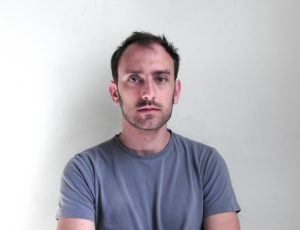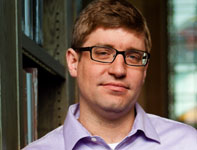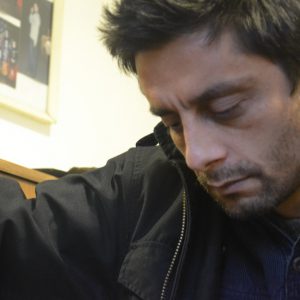CD Review: Tristan Perich: Parallels, for tuned triangles, hi-hats & 4-channel 1-bit electronics (2013)—Meehan/Perkins Duo (Physical Editions 5, 2015, 46 minutes)
I first heard of Tristan Perich from NPR, hardly the bastion of cutting-edge arts journalism. But every now and then they report on someone vital and interesting (whether by accident or knowledge, it’s impossible to tell)—that’s how I also became aware of Guillermo Klein. The Perich spot concerned his 1-Bit Symphony (2010), which had just been released by Cantaloupe. Perich, who studied math, music, and computer science, has devoted much of his work to the exploration of 1-bit electronics, which Piero Scaruffi describes as “a form of digital soundscaping in which each sound can be represented with just one bit of information, the lowest possible digital representation of audio.” The sound world thus produced is deceptively simple, since the combination of the humble electronic sounds can create various acoustic phenomena that give unexpected richness to the timbres. Aesthetically the music explores repetition and slow transformation; in a word, minimalism. While it is clearly related to the early work of Glass and Reich, Perich’s music offers a strong continuation of that aesthetic as a result of his compelling choices for harmony and, above all, the dramatic effects that result from the varying rate at which different patterns change.
Parallels is part of a series called Compositions released on his own imprint, Physical Editions—the others are Telescope, for two bass clarinets, two baritone saxophones, and 4-channel 1-bit electronics; Dual Synthesis, for harpsichord and 4-channel 1-bit electronics; and Active Field, for 10 violins and 10-channel 1-bit electronics (this piece performed with Ensemble Signal conducted by Brad Lubman.) The packaging includes a poster-sized print of the score, and artist editions of 100 will continue the tradition he established in earlier works: furnishing a custom-made player and an archival-quality print of the score. (Perich’s considerable background and acclaim as a visual artist always informs the approach he takes in the release of his music.)
I’ve not heard the other pieces (except for sizeable excerpts from Dual Synthesis), but I can confidently report that Parallels is a major work in Perich’s growing catalogue. Lasting 46 minutes, the 4 separate 1-bit voices supply the pitch material. Each voice in the opening figuration presents a string of four pitches (A5, C6, D6, E6), but each begins on a different note of the string. (Thus it resembles Steve Reich’s early phase pieces.) As the piece continues, the pitches change as do the number notes in a given string. so that the music takes on some of the characteristics of Ligeti’s micropolyphony: although the constant four-voice texture is less complex than Ligeti, it shimmers like his music but also creates regular, constantly changing, dance-like pulsations. And as I remarked earlier, Perich’s deft choices for the pitches create a compelling, dramatic arc for the work.
The percussion parts (tuned triangles and hi-hat cymbals) double selected pitches of the electronics in close, interlocking patterns that I think would be extremely difficult to play accurately. For the recording, the timbre of the percussion instruments tends to add an additional coloration to the electronic sounds, but I’d suppose the act of seeing the musicians playing in real time would make a great contribution to the extraordinary sense of ecstasy that the music generates. Here’s a video trailer that gives a sense of what the piece feels like in concert.
The Meehan/Perkins Duo handle this music expertly—their precision is almost scary—and the sound is fantastic (no surprise, because Michael Riesman mixed and mastered the recording).
So much for a basic description. What is it like to hear such music? The middle to late twentieth century offered many opportunities to contemplate what happens over the course of a long piece that lacks some of the usual formal markers of, say, symphonies or operas: Reich, Glass, Feldman, and Cage all posed very different, compelling possibilities. It turns out that a listener can, if she chooses, find local- and long-range formal shapes in such music—but they are rather fluid and unpredictable. In the early minimalist works of Reich, they’re a bit less ambiguous (because his process works are very systematic and easy to hear). When the patterns of change are sometimes less systematic (as in many early works of Glass), the mind has more space to explore different alternatives.
Perich carries that marvelous ambiguity further in Patterns: one might perceive an important formal juncture around 22 minutes, when (I think) one of the percussionists switches to closed hi-hats. Around 26 minutes, both percussionists are playing hi-hats, now open and closed, and another similar change happens at 35 minutes. Otherwise there are no changes quite as dramatic, and the intervening music (not to mention the asymmetry of the junctures) tends to soften their force as defining moments in the overall form.
A sensation results, then, of not knowing quite where I am—as in the Number Pieces of Cage, Robert Morris’s electronic piece MA, or to a lesser extent, pieces like Michael Nyman’s Vertov Sounds—but as I listen to these pieces again and again, they come to resemble an environment with many different landmarks; some of them attract my attention, but I can never grasp them all at once. Morris expresses the effect in Buddhist terms: as the contemplation of Indra’s Net, a celestial network of jewels each of which reflects the totality of the network. But it’s also like real life: a constant surprise, and a wonderful one, if you take the time and you’re paying attention.



